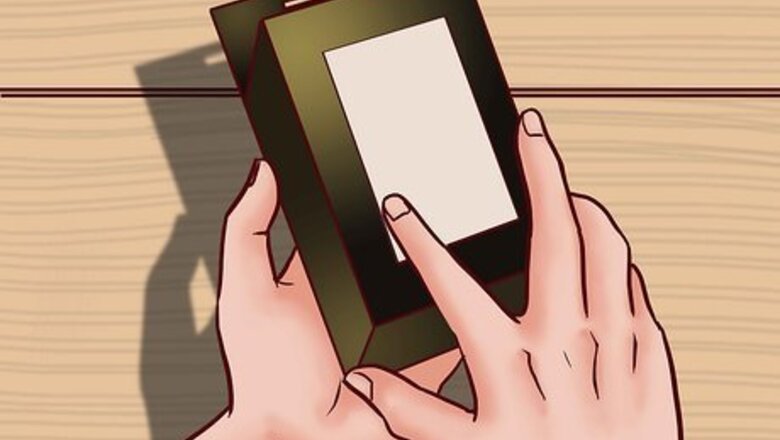
views
Understanding the Cards and Playmat
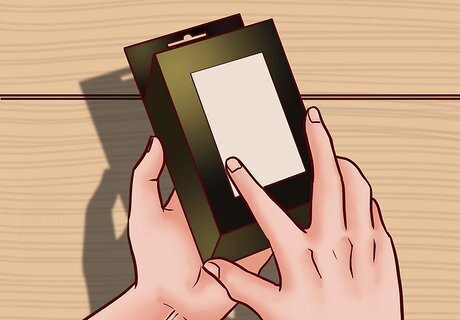
Get a deck. Buy starter decks or booster packs to get cards to play the game. Starter decks are pre-built decks that you can use straight out of the box. If you want to change your deck, buy booster packs to get more cards to use. Each booster pack contains 7 random cards that you can add to your deck or collection.
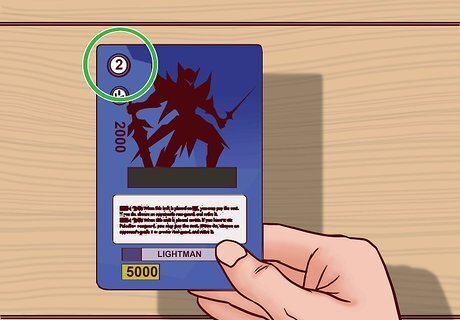
Check the unit’s Grade and Power values. Every card, known as a unit, has a number in the top left corner called the Grade, and the number in the bottom left called Power, and in some units, the number in the left center called Shield. Grades range from 0-5, with grade 0 being the weakest. Grades determine which cards you can play during your turn, Power determines how well a unit does during an attack, and Shield determines how well the unit does when guarding(Refer to Part 5 Step 1 for more). Stronger cards usually have a higher Power and Grade than weaker cards, but they cannot be played until later in the game. Balance the unit grades in your deck so you have 17 Grade 0 and about 15 Grade 1, 10 Grade 2, and 8 Grade 3 units(And for Original series, up to 16 G units). Note that a deck must have exactly 50 cards(Excluding the deck in the G zone), 16 of which must be Trigger Units(Refer to Part 1 Step 6 for more).
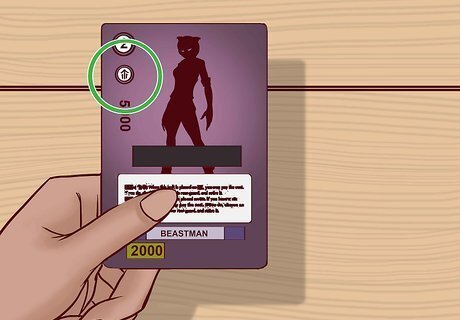
Look for abilities underneath the unit’s Grade. You can use skills throughout the battle to help give you a tactical advantage during your turn. Each skill can only be activated at specific times during the game. There are 4 different skills that a unit may have. The boost skill has an arrow pointing up and means the unit can be used to boost the power of another unit that’s attacking. This is an optional skill during your Battle Phase. The intercept skill resembling a checkmark and allows the unit in play to guard an incoming attack. This is an optional skill, and is only usable during your opponent's Battle Phase. The twin drive and triple drive skills resembling interweaving arrows means you perform that many drive checks during a battle(Refer to Part 4 Step 2 for more). This is a compulsory skill.
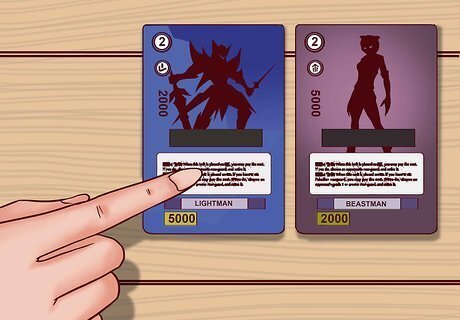
Read the card’s skill near the bottom of the card. You can activate a unit’s skill once per turn at the time listed in the text. These abilities can help your units gain power or allow you to perform special actions during the game, but you don’t have to use the ability if you don’t want to. Follow the text on the card carefully to activate the ability. Many abilities only affect certain zones on the playmat and require a cost, such as discarding cards from the top of your deck or from your hand, or sending units to the drop zone. Abilities labeled ACT can be activated during your Main Phase for any number of times – as long as you pay the cost each time. Abilities labeled AUTO triggers automatically once the conditions listed on the card are met. For units with a CONT ability, the ability is active as long as the card stays in play. Some CONT abilities require certain conditions to activate.
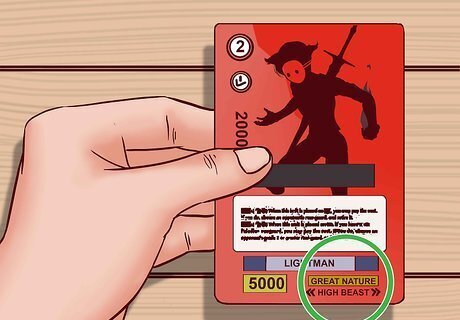
Locate the clan and race of your unit. Look for the names listed near the bottom right corner of each unit. The clan and race of your card may be important for activating certain unit abilities, but they don’t affect the gameplay otherwise. As of February 2019, there are 24 different clans, 6 different nations and 69 unique and shared races. Each clan has a unique play mechanic as well as their own strengths and weaknesses.Note: You can only use units from a single clan(For Original and V series)/nation(For Overdress series), with the exception of Cray Elemental cards which can be used in all decks. Only 4 copies of a card with the same name may exist in a deck.
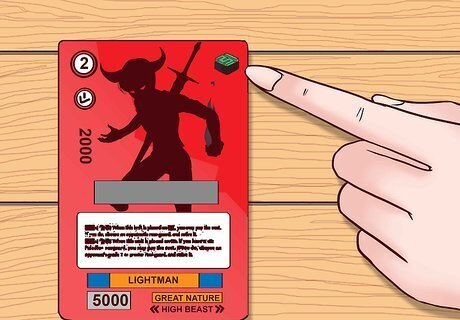
Find the trigger icon in the top right corner of the card. Such units with a yellow strip on the bottom of the card are called trigger units, and they can affect the outcome of a battle. The symbol in the top right corner of trigger units shows the effect that happens when they are revealed. Each trigger lets you choose 1 unit to gain 5000 power(In the original series) or 10,000 power(In the V and Overdress series), and one of 6 different effects that can happen after(Certain series may not have certain triggers). Critical triggers allow you to choose a card and increase the damage it deals by 1. Draw triggers(引) lets you draw 1 card from your deck and add it to your hand. Stand triggers(醒) lets you stand a rear-guard, but it cannot perform drive checks for the rest of the turn. Front triggers(前) give all units in the front row on your side of your field an additional 10,000 power. Heal triggers(治) allows you to remove 1 damage from your damage zone if you have more or equal damage cards than your opponent. Up to four Heal triggers can be placed in a deck. Over triggers(超) remove themselves from the game and apply several effects when revealed for checks. When revealed as a damage check, you draw one card and choose one unit to gain 100 million Power. If revealed during your drive check, perform the above and activate it's additional effect. Only one Over trigger can be placed in a deck.

Familiarize yourself with the zones where you place units on the playmat. Vanguard has a unique playmat where you place units throughout the match. The space with the letter V is referred to as the Vanguard Circle(VC), while the 5 other spaces with the letter R are known as Rear-guard Circles(RC). When you play units during your turn, they must go in these zones. The G at the top of the playmat is the Guardian Circle(GC) and is used to defend against enemy attacks.
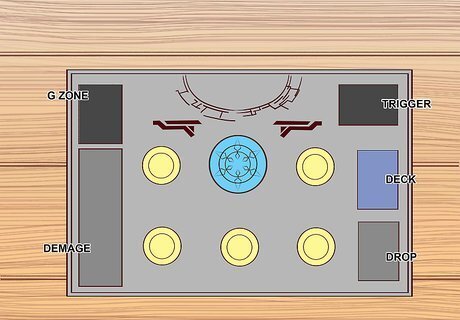
Learn the other zones on the sides of the playmat. Besides the zones where you can play units, there are 5 other zones where cards go throughout the match. These zones are used for cards that you draw, discard, or track damage throughout the game. Place your deck face down on the deck zone on the right side of the playmat at the start of the game. The drop zone on the bottom right side of the playmat is where your cards are placed when they’ve been defeated/retired in battle or discarded for certain effects. The damage zone is where you’ll stack your damage cards when your vanguard is attacked and receives damage. The top left of the playmat is the G zone, where you can keep up to 16 G units(Formerly 8), stronger units that you can access later in the game. Units in the G zone are separate from the units in your deck. Place any G units there face down at the start of the game. The trigger zone is directly above your deck and is used during drive checks. Everything except for your deck, hand, and the cards in your G zone is public information.Note: The G zone is available only to the Original series. In Overdress series, the same zone is known as the Order zone used to play Set Orders. This will be further explained in the future.
Beginning a Match of Vanguard
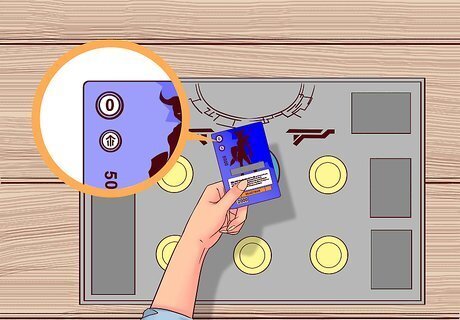
Place a Grade 0 unit onto the Vanguard Circle. Search through your deck and locate a unit that has a 0 in the top left corner and place it on the Vanguard Circle face down. It is recommended to choose a grade 0 unit without a trigger icon. This card is your starting vanguard(Or First Vanguard(FV)), but you will be able to make it more powerful each turn. Don’t reveal your vanguard right away since it may affect your opponent’s strategy when drawing cards.
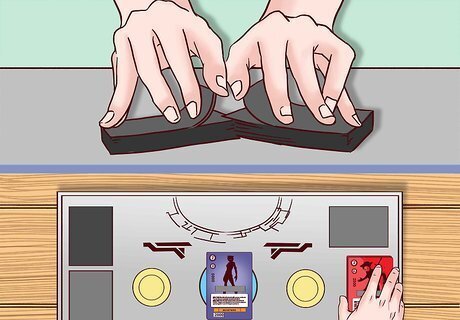
Shuffle your deck and draw 5 cards. Once you and your opponent have selected a vanguard, shuffle your deck so it’s thoroughly mixed. Place your deck in the Deck zone on the right side of your playmat before drawing 5 cards from the top. Those cards are your starting hand.Tip: If mulligan is available, during your first draw, you may place any number of cards on the bottom of your deck and draw the same number of cards from the top of your deck. If you do, shuffle your deck again. This can only be performed once.
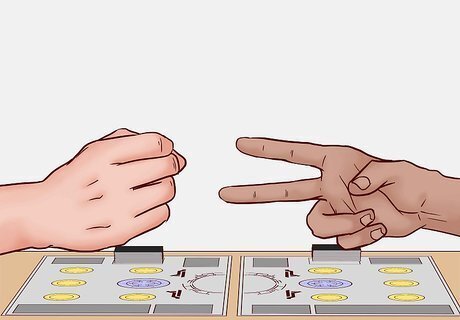
Play rock paper scissors to determine who goes first and reveal your vanguards. Whoever wins the game of rock paper scissors takes the first turn. As soon as the turn order is determined, flip over your vanguards at the same time to reveal them("Stand up, Vanguard!"). The game starts with the first player as soon as vanguards are flipped.
Starting Your Turn
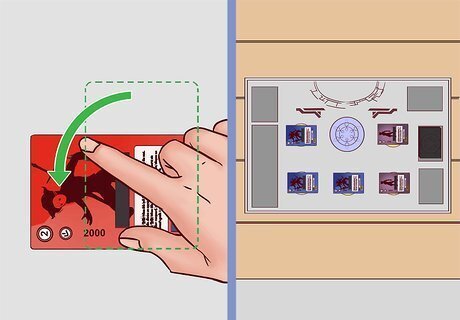
Turn all of your cards in horizontal position on the field vertical before drawing 1 card from your deck. If you have any cards that are horizontal, or "rested", turn them vertical to “stand” them so they can be used during your turn. This is known as the Stand Phase. Once all rested cards are standing, draw a card from the top of your deck and add it to your hand. This is known as the Draw Phase. The entire process is known as "Stand and Draw". You will not have to stand any cards during the first turn, but Stand Phase will still be declared. Some units might have an ability that triggers at the beginning of your turn. If so, you can choose to activate them if you want so long as the cost can be paid.

Play a unit from your hand on top of your vanguard. Use a card from your hand that has the same grade or a grade that’s 1 more than your vanguard, and place it on top of your current vanguard vertically. This is called the Ride Phase and the action is known as “riding”. Riding allows you to play stronger cards later during your turn and makes your vanguard more difficult to be defeated. Choose to activate any unit abilities that occur at the beginning of the Ride Phase or when a card rides. The cards underneath your vanguard are referred to as your vanguard’s soul, which can be used for Soul Blast(SB) by sending that many number of souls to the Drop Zone. You may choose to ride or skip the phase.
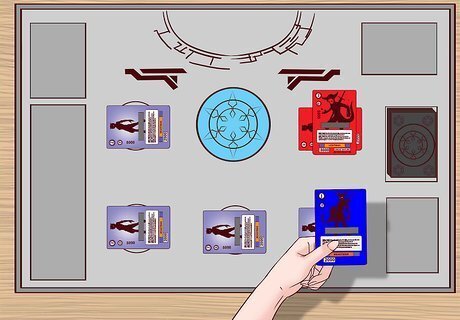
Summon units in the rear-guard circles. During your turn, choose any number of units from your hand to play on any of the rear-guard zones in the vertical position. This action is known as "calling". The units you play must have a grade equal to or less than the grade of your vanguard. If you already have units on the field, you can move or exchange them between rear-guard zones vertically, but not horizontally. This part is known as the Main Phase of your turn. You may activate any abilities that occur during the Main Phase or when a card is played on a rear-guard zone. If you play a unit on a rear-guard zone that already has a unit, put the unit that was there into your drop zone.
Attacking and Damaging Your Opponent’s Units
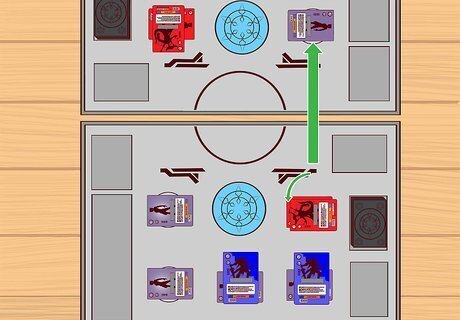
Attack your opponent’s cards by turning a front row unit horizontal. At the end of your Main Phase is your Battle Phase, where you can now declare attacks at your opponent's units. When you want to initiate a battle, turn the unit you want to use sideways so it’s horizontal in its zone. Unless stated otherwise by a skill, only front rows units may declare an attack. Choose an opponent’s unit in their front row and declare your attack so your opponent knows what you’re targeting. You can choose to activate any unit abilities that triggers during Battle Phase or when a card attacks. You cannot initiate battle during the first turn of the game. You can attack multiple times as long as you still have standing units in the front row. You may choose to end your Battle Phase early even if you can still attack, which ends your turn and passes it to your opponent.
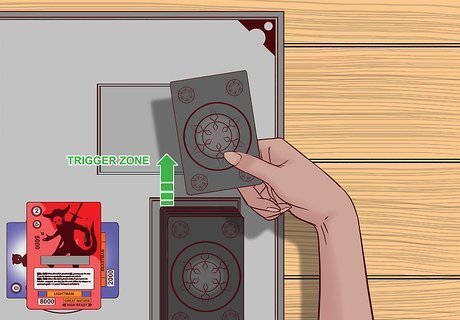
Check for triggers if you’re attacking with your vanguard. When your vanguard attacks, reveal the top card of your deck and place it in the trigger zone. This is known as a drive check. If the revealed card has a trigger symbol in the top right corner, then apply the effects of the trigger. If it isn’t a trigger unit, then no effect is applied. After doing so, add that card into your hand. You may choose to activate any abilities that trigger during the drive check. If your vanguard has a twin drive or triple drive skill indicated below its grade, then it must perform 2 or 3 drive checks respectively. Trigger effects must be resolved first before performing the remaining drive checks.
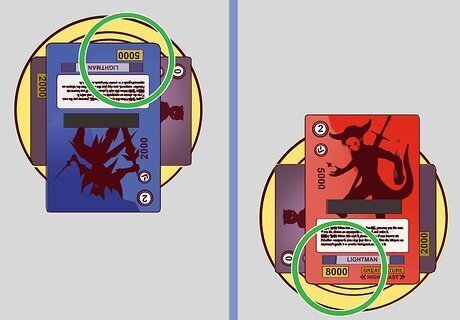
Compare power levels between your unit and the card you attacked. Check the Power of your attacking unit and compare it with the Power of the unit you targeted. If your Power is higher or equal, the attack hits. If a rear-guard is hit, it "retires" and moves to the drop zone. If a vanguard is hit, they perform a damage check(Refer to next step). If your power is lower than your opponent’s unit, the attack doesn’t hit and the battle is over. You can trigger any ability that activates during battle. Such examples are when the unit attacks, the attack hits, at the end of that battle, or at the start of the damage step.
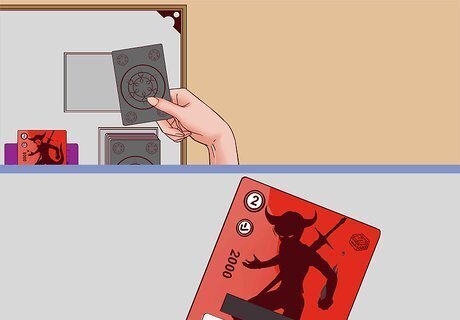
Deal damage if you attacked your opponent’s vanguard. If the attack hits your opponent’s vanguard, look at the number in the bottom center of the unit you attacked with. This is the unit's Critical used for dealing damage. Your opponent must then perform a damage check by taking that number of cards equal to the attacking unit's Critical from the top of their deck and placing it in their trigger zone one by one. If it has a trigger symbol in the top right corner, your opponent resolves the trigger and chooses which unit to receive the effects. Then, they place the card they drew in the top-most slot of their damage zone face up. Similar to drive checks, each damage check effect is resolved prior to the next damage check. Activate any effects that occur during a damage check. If the card revealed during a damage check has an AUTO effect that occurs during the damage check, then the ability is activated before the card goes in the damage zone.
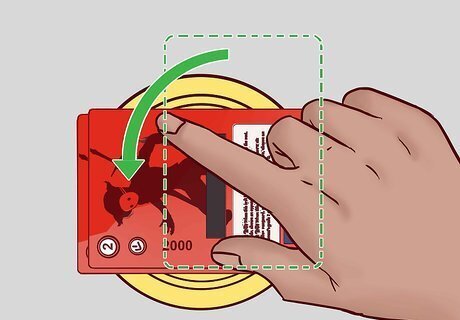
Resting your attacking unit. Whenever a unit battles another unit, it rests and cannot be used again during that turn unless affected by an ability to stand again. Turn the unit sideways so it’s in the resting position. Rested cards can be used again after your next Stand phase. You can still use the ability of a resting unit as long as the cost is paid, but only during your Main Phase(Unless stated by the ability otherwise).
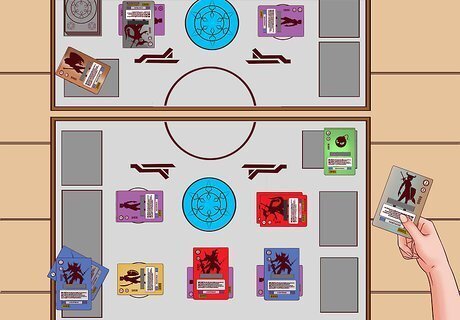
Continue playing until a player takes 6 damage or depletes their deck. Keep alternating turns between your opponent for the rest of the game. If either player has 6 or more damage in their damage zone, they lose. If any player ever run out of cards in their deck at any given time(And when no abilities are currently resolving), they also lose.
Boosting Your Power
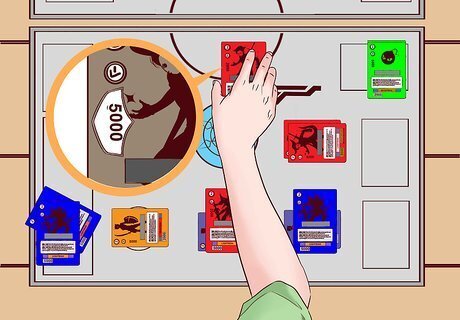
Place units in the guardian circle to add power to a unit that’s being attacked. During your opponent's Battle Phase and you are attacked by an opponent’s unit, you will enter the Guard Step. In this step, you can use cards from your hand to help defend the unit being attacked. Check on the left side of the card to see if it has a value. This is known as the Shield Value. To guard, play the card horizontally on the Guardian Circle and add the shield value to the power of the unit that’s being attacked. You may guard with any number of units, but the shield will last until the end of that battle. After that, any unit you played for guarding will be sent to the Drop Zone. You may also use any units in rear-guard circles that have the intercept skill indicated below their Grade to guard. This is usable only if the intercept unit is in your front row and is not targeted by the attack.
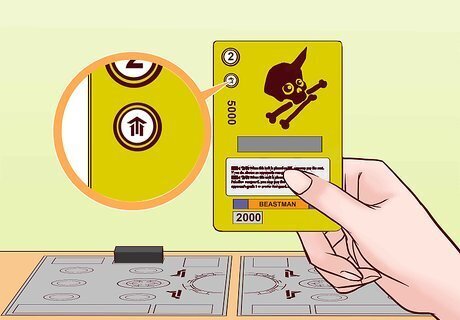
Rest units with skill icons to get boosts during your turn. When you attack, you can have the card with the Boost ability directly behind the attacking unit to increase their power. Look at the top left corner under the unit's Grade to see if it has a boost ability and turn the card sideways if you want to use it. To boost, rest the Boost unit before resting the attacking unit in front of it, and take the power from the unit you used to boost and add it to the power of the unit that’s attacking. You can only boost power during your own turn.
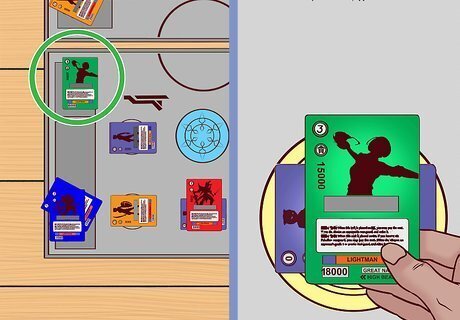
Activate a Stride ability to play a G unit from your G zone. If you and your opponent both have vanguards that are grade 3, you can choose to “stride” a card after your Ride Phase. To stride, discard cards from your hands whose total Grades sum up to at least 3 to the drop zone. Then, choose a face down card from the G zone at the top left of the playmat and place it on top of your vanguard. Add the power of the G unit and the vanguard underneath it together. G units are extremely powerful and can help you make a game-changing play during your match. When your turn is over, the G unit is placed back in the G zone face up. Face up G units cannot be chosen to be stride for the rest of the game(Unless stated by an ability otherwise). Units in your G zone are separate from your deck.











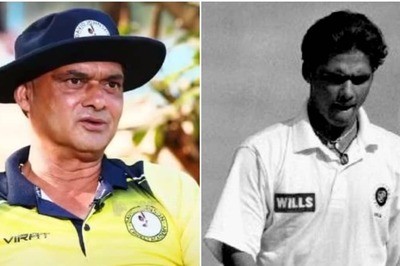








Comments
0 comment